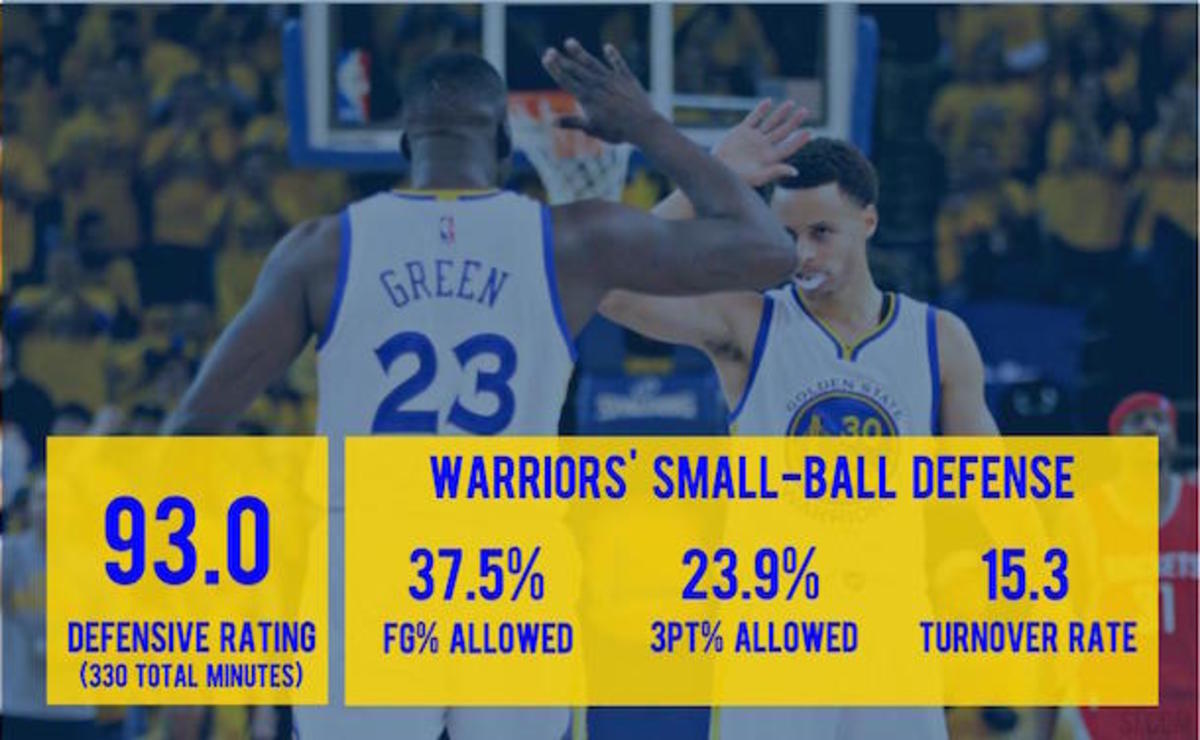Draymond Green at center of the Warriors' small-ball advantage

The worst that can be said of Golden State's take on small ball, which features 6'7" Draymond Green at center, is that it's situational. There are times when Warriors coach Steve Kerr would rather not risk the deficits in rim protection and rebounding that come with taking a traditional center off the floor against the wrong matchup. The Warriors' most common small-ball variations still rank among the team's best lineups, as Kerr well knows. All that's needed to maximize their effect is some discretion in deciding when they should be employed.
In that regard, the Rockets are an especially forgiving opponent. What Green gives up in size to Dwight Howard he makes up for in strength, quickness, and grasp of basketball's dark arts. That's a matchup Golden State can survive, because Green is physical and mobile enough to both take away some Howard screen-and-rolls and stay solid on any post-up attempts that come his way. Howard's frontcourt counterparts, Josh Smith and Terrence Jones, aren't problems in the slightest for lanky wings like Harrison Barnes and Andre Iguodala. Whatever momentary advantage can be gained from their size isn't so significant a threat as to cause concern.
- MORE NBA: Curry's next stage | Curry on NBA All-First Team | Preview
This is where Golden State's small ball stands apart. When teams around the league opt to run smaller lineups by choice, they typically do so for the sake of their offense. The exchange of a traditional center for a more mobile power forward and of a power forward for a stretch shooter can open up even the most static offenses. There is demonstrable value in having the right kinds of scoring threats on the floor at the right distance.
2015 NBA Mock Draft 2.0: Projecting the first round with lottery order set
Defensive integrity is usually the offsetting cost. Giving up size across the frontcourt makes most teams vulnerable to drives, cuts, and offensive rebounds. It's just not so for the Warriors—at least not to a degree that should in any way deter the use of small lineups. In Game 1, we saw undersize, overly flexible Golden State apply the clamps to Houston's offense with Howard still on the floor.
This confirmed the greater trend we've seen throughout the regular season and playoffs: In controlled stretches, the small-ball Warriors ramp up the pace, improve their spacing, and—contrary to type—maintain an excellent team defense:

Data: NBAWowy. Photo: Ezra Shaw/Getty Images.
The question the Warriors face is not if they should go small in their series against the Rockets, but for how long. Houston's rotation and Howard's knee injury (the full implications of which won't be known until Game 2) make its usage a no-brainer; the risks of going small are muted in this series, and the gains are obvious. Notable bumps in shooting efficiency almost across the board and an inflated pace that can quickly blow open a game will follow.
The only catch is the very same that Kerr has noted all along. Here's what the Warriors coach said of using Green at center back in March (via Tim Kawakami of the San Jose Mercury News):
"We generally like to have Bogut at the rim for defense, that’s when we’re at our best, when we can switch everything but still have the rim protection. But yeah, we can do it to other teams as well if we choose. You know, it takes a lot out of guys to play that way; it really is taxing. So I would rather use it in spurts, which we try to do, then do it the whole game. But it’s definitely a weapon that we can use against other teams, too, not just react to other teams.”
Running small asks a lot of Green, who must deal with an exaggerated size disadvantage while acting as his team's last line of defense, running the floor, and driving whenever possible to attack a slower opponent. It asks a lot of Barnes and Iguodala, who need to transition quickly from hard box-out to transition sprint. It asks a lot of whoever is guarding Harden (Klay Thompson, Iguodala, or Shaun Livingston) to do so without superior rim protection. It even asks more of the Warriors' other perimeter players, who have to scramble more consistently on defense without Bogut on the floor and could be switched mid-possession to cover even bigger opponents should the occasion call for it.
If Golden State isn't at its best with Green playing the five (an arguable point), it's at least at its purest. Never are the Warriors more unguardable, more frenetic, or more wearying. Through those lineups, their already aggressive style becomes restrictive, with most opponents forced to compromise their own rotations as they attempt, often in vain, to combat the propulsive rhythm that Golden State stokes freely. Once they reach tempo, the small-ball Warriors' greatest adversary is burnout. None—not even the pace-pushing Rockets—can run with them.
